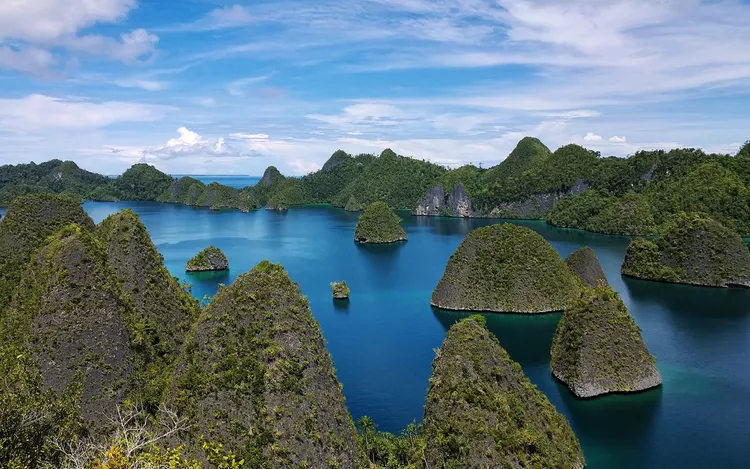Journey Through Papua New Guinea: An Adventure Awaits
It’s not easy to travel to Papua New Guinea. The exact qualities that make the country so attractive to adventurers—its rugged natural beauty, thriving traditional cultures, and an anachronistic lack of infrastructure—are precisely what makes it such a challenging destination. The Australian government’s travel guidelines for the country serve as a long warning about various potential hazards: Landslides, car-jackings, gang violence, venomous snakes, and civil unrest.
Discovering Papua New Guinea
The eastern half of the second largest island on earth, Papua New Guinea first gained notoriety in the Western world after Errol Flynn visited in 1927 and declared the land one of his greatest loves. In 1930, while searching for gold, Australian brothers Mick and Dan Leahy discovered a million isolated people living in the lush, secluded valleys of the Highland. Previously thought to be uninhabited, it was actually the most densely populated region—an impressive anthropological discovery. Altogether, Papua New Guinea has one of the world’s most diverse cultural and linguistic landscapes, with over 800 indigenous languages, or 25 percent of the world’s spoken tongues.
Moreover, the country is steeped in a history of mystery and myth, which captivates travelers. With its unique topography, prolific birdlife, and remote indigenous cultures, Papua New Guinea has been a place of fascination for many adventurers.
Arrival and Exploration
My travel partner George and I arrived in Port Moresby, Papua New Guinea’s dusty capital, last November, after a 25-hour journey from Los Angeles. After visiting the National Museum, Parliament House, and the well-maintained botanical gardens, we flew to Mount Hagen in the Southern Highlands, overlooking the Waghi Valley, which is home to the Melpa people. Our travel was organized by a local agent, essential for navigating the complexities of domestic travel in Papua New Guinea.
Although I had heard various stories concerning PNG’s raskols—hoodlums—and noticed significant rioting during our nine-day journey, I encountered only one unnerving moment. While strolling through Hagen Market, where a variety of goods were on display, I narrowly escaped a theft attempt. Fortunately, I managed to slip aside just in time. Fortunately, the locals reacted swiftly to the situation, showcasing their sense of community and justice.
Cultural Richness
A different scene unfolded in Pulga Village, where young men from the Wurup clan, covered in white clay, danced amid the tropical foliage, blending traditional beliefs with Christianity. Although the majority of Melanesians identify as Christian, animism, ancestor worship, and cultural practices still pervade the region.
Flying northwest in a small plane, we landed near the Karawari River, immersed in a lowland rainforest environment that felt worlds away from modernity. As we traveled upriver, we observed subsistence farmers living in their traditional ways, virtually untouched by the outside world.
After arriving at Karawari Lodge, the experience was further enriched by interactions with the local tribes. We traveled to Kundiman Village, where the Yokoium tribe welcomed us into their daily life, sharing their culinary traditions while dressed in traditional attire. This immersive experience in various villages revealed the poignant realities of education and government efforts, as well as the ongoing issues faced by the local population.
Adventure and Nature
Out on the river, we traveled to Konmae Village, where a teenage girl glided by in a canoe. She carried a cuscus atop her head, and as I looked closer, I noticed the scars of tribal affiliation on her back—an incredible testament to cultural practices.
We continued our journey to Tanganbit Village, home to the Alamblack tribe, historically known for headhunting. The rich history and traditions offered a glimpse into a lifestyle that has persisted through time.
Travel Logistics
Getting There
From LAX, connecting services to Port Moresby are available through Cathay Pacific, Singapore Air, or Qantas. Round-trip airfare typically begins at $2,165, inclusive of taxes and fees. As domestic air travel in PNG is complex, arranging it through local experts is highly recommended.
Accommodations
For lodging, visitors can opt for:
- Airways Hotel – An aviation-themed hotel near Jacksons International Airport, providing excellent security and amenities.
- Rondon Ridge – Located high above sea level with magnificent views.
- Karawari Lodge – Nestled amidst rainforests with rustic charm.
- Ambua Lodge – Offering stunning views and a unique highland experience.
What to Bring
Travelers are advised to leave behind blue jeans and jewelry, focusing on utility over fashion. A good flashlight and extra pairs of walking shoes are essential, as many lodges lack electrical facilities at night.
Further Information
For more details about Papua New Guinea, you can contact the embassy or visit their official tourism website for general information and trip planning resources.





